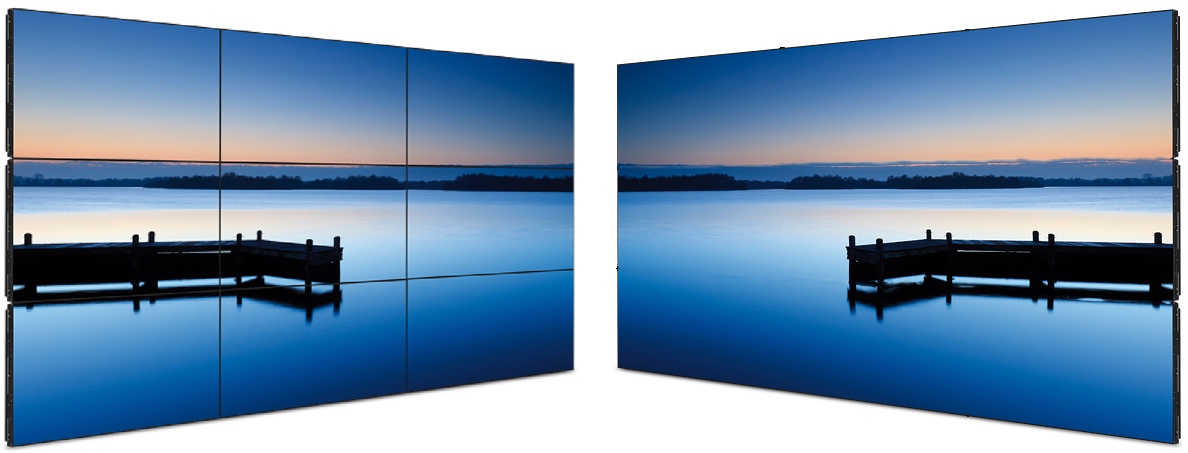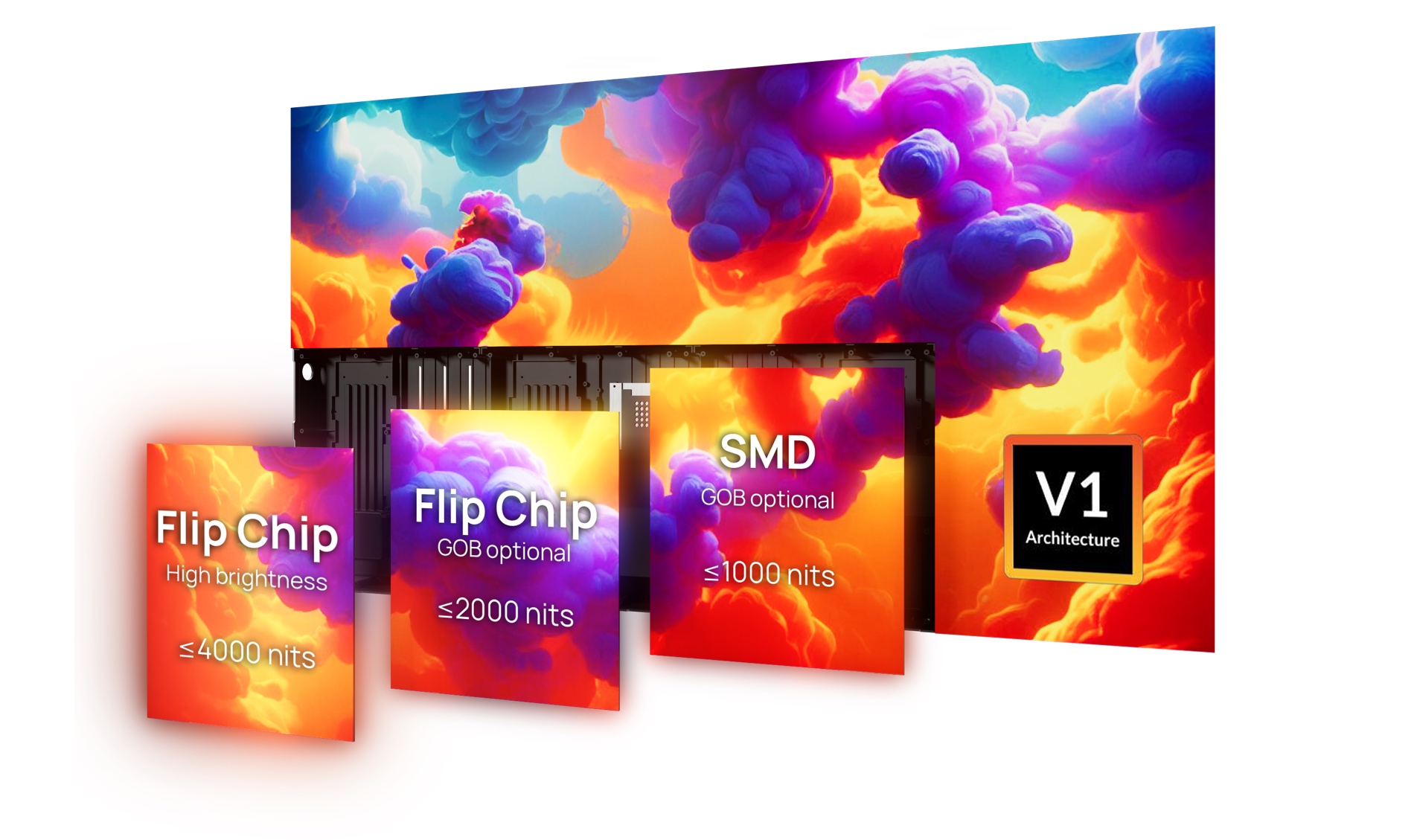LCD has been pivotal to the evolution of large format displays. Many LCD video walls that were installed during the digital signage boom are now reaching the end of their life, raising the question of what to replace them with.
LED is now a strong contender in this space, thanks to our Multi Award Winning EDGE series. The 43" EDGE Pro, 55" EDGE, 54" EDGE Pro and 65" EDGE offer a long-awaited direct replacement for LCD video wall displays, thanks to their single die-cast cabinet structure in the same size as the most popular LCD video wall panel sizes. The benefits include reduced installation time, increased serviceability, reduced weight, enhanced performance, and improved sustainability credentials.
Forming an understanding of the key differences between the two is vital to help make an informed decision about which technology is optimal for your project solution.
So let’s open get back to basics!
LCD displays work by using a backlight to illuminate the liquid crystals that make up the display. The liquid crystals are arranged in such a way that they block or allow light to pass through, creating the image that you see on the screen. And most importantly, all video wall panels have bezels!
LED displays, on the other hand, use a different method to produce light. Instead of using a backlight, LED displays use tiny light-emitting diodes to produce light directly. This allows for greater control over the brightness and colour of the display, and also makes it possible to produce commercial displays that are thinner and more energy-efficient than LCD displays.
Traditionally, LCD displays have been quicker and easier to install due to their larger size compared to LED modules. Although, video wall braketry can be difficult to align and install. The 43" EDGE Pro, 54" EDGE Pro, 55" and 65" EDGE Pro panels, however, are the largest single die-cast LED cabinets available on the market and have been designed to rival the most popular LCD video wall panel sizes, allowing for a direct technology swap!
Each cabinet incorporates eight LED modules, and uses approximately four times fewer internal cabinet components than conventional LED cabinets combined to the same size. As a result, this reduces power consumption, installation time, global shipping costs and reduces the product's environmental footprint.
In terms of aesthetics, the EDGE series 16:9 cabinets deliver seamless, bezel-free display configurations featuring various shapes and sizes, offering an outstanding visual display solution.

Break free from complex bracketry! The EDGE series weighs a maximum of 11kg (43") or 15kg (55") per cabinet and has a depth of just 38mm. Moreover, these can be directly wall-mounted or used with existing video wall bracketry or mounts for quick installation, resulting in an easy, seamless, and quick integration into any environment.
This significantly reduces installation time and costs. EDGE modules are also serviceable from the front, allowing direct access to critical components for convenient maintenance, which can be performed by a single engineer unlike large video wall panels. If an LED display module becomes faulty, it is a simple one-person swap.
LCD panels used in video walls can often drift in terms of colour uniformity, resulting in a patch work of panels that are not perfectly matched. Finding replacements that match exactly can be tricky. With LED display technology, spares are batch matched to ensure perfect uniformity. Modules can be quickly calibrated to match surrounding diodes, by eye or using a calibration camera.
LED tends to yield a higher initial investment. However, we are viewing a change in trends as the cost of LED reduces and becomes more accessible. LED has a much lower running cost than LCD, which means that although LED has a higher upfront cost (for now), you can quickly claw back your initial investment and end up in the green.
Generally speaking, the maximum lifespan of LCD is 3-5 years, compared to up to 11 years with LED displays. This means you’d need to look at replacing your LCD four-five times in the entire lifespan of a single LED display.
LED displays are generally far more energy-efficient than LCD displays.
The EDGE is one of the most sustainable and energy-efficient LED displays available. The advanced design keeps heat away from the individual LEDs and dissipates it through superior heat management techniques. As a result, using this state-of-the-art design reduces power consumption by up to 40%, without decreasing the brightness or contrast ratio.
Reducing your display power consumption has never been more important at a time in which we are experiencing continuously soaring energy bills, as this can cause a real dent in the bank for businesses running digital signage 24/7.
Want to find out more about how you can reduce your display running costs?
On the brighter side of things… let’s talk about brightness!
LEDs are capable of reaching peak brightness levels into the thousands of nits, whereas standard LCDs offer hundreds of nits. This vast difference enables the brightness level of LEDs to be set lower than the peak, let's say 50%, which over time can be dialled up to keep the appearance of its brightness consistent across the entire screen and lifespan.
LCD not only starts with lower brightness capabilities, but deteriorates at a faster rate. This is often most apparent in video walls, where panels diminish at different speeds, and inconsistencies are instantly noticeable.
LED displays are renowned for their exceptional contrast ratios compared to traditional TV screens, significantly enhancing image quality. This superiority in contrast is largely attributed to the way LED displays handle black levels. In an LED screen, achieving true black means turning the diodes completely off, in contrast to other technologies that may only dim them. This capability not only produces deeper blacks and more vivid colours, thereby improving the overall viewing experience, but it also offers a unique advantage in terms of energy efficiency.
Content creators can utilise this feature to design images or videos that consume less power, particularly in scenes with predominant dark areas, ultimately leading to cost savings for users. By leveraging the inherent characteristics of LED technology, both image quality and energy consumption can be optimised, making LED displays a smart choice for both visual fidelity and environmental sustainability.
Market-leading design allows the 43" EDGE Pro to evolve as pixel pitches and manufacturing methods continue to change, enabling technologies to be swapped out without changes to bracketry and mounting infrastructure or cabinets.
Pixel pitches can be updated and reduced simply by changing the modules. This is made possible because each module, no matter what the original pixel pitch, can fit the 43” or 55” cabinet. This means a 2.5mm pixel pitch display, for example, can easily be upgraded to a 1.2mm by simply refreshing the panels, and evolved from SMD to Flip Chip.

We encourage everyone to focus more on sustainability in all aspects of life, including display technology choices.
Reducing energy consumption helps minimise environmental impact, and simultaneously, the extended durability of LED displays helps save materials and maintenance for possible repairs.
Ultimately, it's important to do your research to find the display that’s right for you. However, if you look beyond the display and consider the total cost of ownership, you'll be rewarded for years to come.
Take a deeper dive in to the technology that drives our Award Winning EDGE Series LED display.